Fatehpur Sikri: A Labor Of Love, Abandoned For Lack Of Water
Civilizations have perished and cities have been abandoned throughout the world due to drying up of natural sources of water.
The first planned township of Mughals, Fatehpur Sikri, now a UNESCO World Heritage Site, near Agra was one such city established with utmost passion by the Mughal Emperor Akbar but later abandoned for lack of water.
But those were the times when wide expanse of land was available, population was much less and water was still not a scarcity. The people in those times had a choice to leave a place and settle closer to water somewhere else. Times have however changed now and there is no place to establish a new city. Fatehpur Sikri is a fine example to understand how unmindful usage depletes and exhausts natural resources.
Abandonment of Sikri illustrates the need to Save Water.
A Prehistoric Site:
Located on upper red sandstone ridges of Vindhyas Mountain range, Sikri once had abundant water in a natural lake. Sikri finds it mention as “Saik” in inscriptions found dating back to age of Mahabharata. Excavated Jain sculptures from 1010 AD mention the name as ‘Sekriya”. The word Sikri is probably a derivation of this. The site had human presence all through the different ages.
Mughal Fascination:
Much later Babur, in 1527, post his victory in Khanwa, found the site quite to his liking and made a garden, a small palace and a baoli or step well for water. Years later, Akbar, Babur’s grandson decided to shift his capital from Red Fort, Agra to Sikri post his victory ‘fateh’ over Gujarat and name the place as ‘Fatehpur Sikri‘.
The Emperor, it is said was childless for many years. It was with blessings and predictions of Chisti saint Sheikh Salim, that Salim better known as Jehangir(his wife was a strong presence and built tomb for her father Itmad-ud-daula at Agra) was born. After his son’s birth, Akbar planned a walled city at hill near the saint’s abode. His victory over Gujarat gave him another reason in realizing his dream of raising a town.
Town Planning And Architecture:
The walled city which once sat high up on a ridge, is now approached by a tarred road right up to the massive entrance gate. It was occupied just about for 13 years after its completion in 1571. As the spring-fed lake supplying for water needs of the walled city began to dry up, it became difficult on the terrain. The city was abandoned in 1585.

Town Plan
With craftsmen hailing from Gujarat, Bengal and local stone carvers, the red sandstone architecture of Fatehpur Sikri is an amalgamation of Hindu, Jain and Islāmic styles. With water channels, underground drainage, pavillions, mosque, school and wide streets, the city was well planned. The guides at Sikri also explain about the ‘venturi effect’ which was successfully used in layout and design of structures that resulted in draft of air and natural cooling of interiors.
The entire complex had close to 9 huge arched gateways of which a few survive in good condition.
Some Magnificent Structures At Fatehpur Sikri:
Buland Darwaza:
The huge gateway built to commemorate his victory is the first thing that seems synonymous with Fatehpur Sikri. Built in 1601 with red sand stone decorated by white and black marble, it holds the honor of being World’s Highest Gateway at 54 meter height from ground level. Approached by 42 steps, this southern entrance of the city has Quranic verses inscribed in Persian on its face.
As I stood gazing up to its top, it was impossible to imagine amount of effort that must have gone in making the stupendous structure.
Across the gate I could see the dilapidated domes of ‘Hamam’ or Turkic Baths.
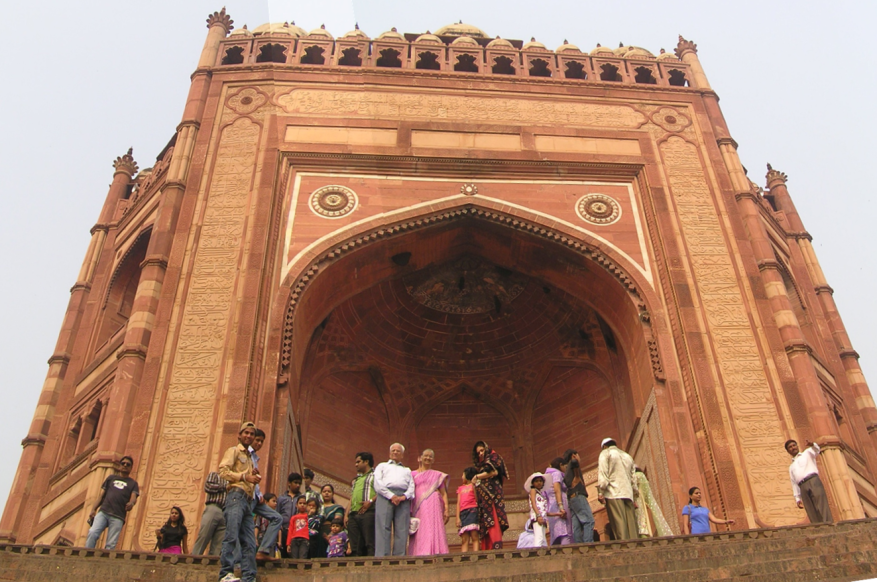
Buland darwaza
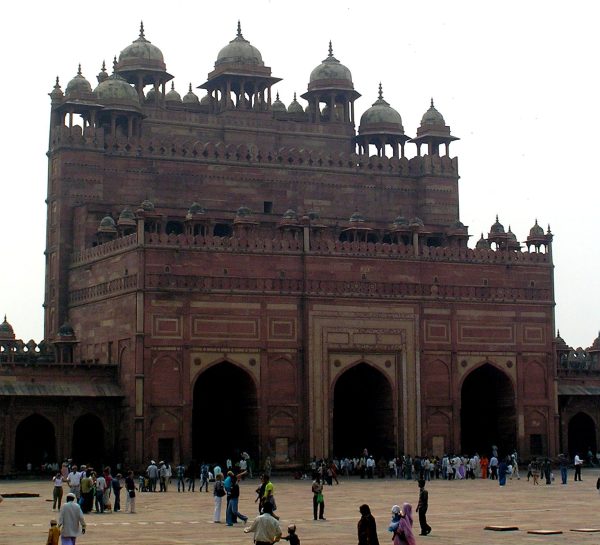
The rear side of Buland darwaza from Masjid’s courtyard
Jama Masjid:

Jama Masjid and courtyard
The mosque is one of the largest mosque in India and most visited in Agra. It shows traces of both Islamic and Iranian architecture. The Buland Darwaza and Salim Chisti’s tomb become a part of msque complex.
Tomb Of Salim Chisti
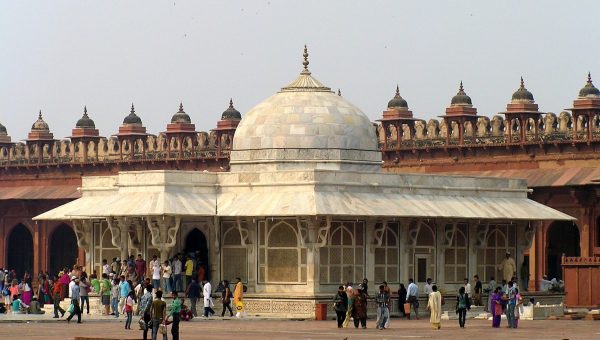
Salim Chisti Dargah
Who ever has visited Fatehpur Sikri has not forgotten to tie a red thread on the fine lattice-work of the marble tomb to send a special request to the almighty. It is surprising how the two religions who mostly are at loggerheads with each other in the country, unite at the tomb. Hindus and Muslims both tie the holy thread in hope their wishes will be fulfilled by their different Gods or by the spirit of the saint.
Intricate marble jali panels make the four walls of the tomb and the central hall is where the saint’s body is laid to rest.
Panch Mahal

Panch Mahal
Also known as ‘Badgir’ or wind-catcher tower this structure was solely for relaxation and entertainment. The five storied pavilion consists of pillared terraces decreasing in size as it rises. The terraces are supported by beautifully carved 176 pillars in all.
A covered platform opposite the structure might have been a girls’ school. The open space near Panch Mahal has markings which seem like a game of ‘chaupar’ or ‘pachisi’ a board game where cowrie shells were used as dice. The difference however was that while a board game had small pegs, this large game drawn on the floor was where Emperor played with slaves as pegs.
Anup Talao
A square pond with stone bridges in cardinal directions which ended in a platform in the center of the pond is located just opposite the emperor’s bedroom close to Panch mahal. the guides tell you that the platform was used by musicians to perform for the king. It was where the famous poet-musician ‘Tansen’ used to sing his ragas.
The pond lies dried up now and the sun sears the stone terraces of Fatehpur Sikri.
Diwan-i-khas

Raised platform with pathways where all religions were discussed in Diwan-i-khas
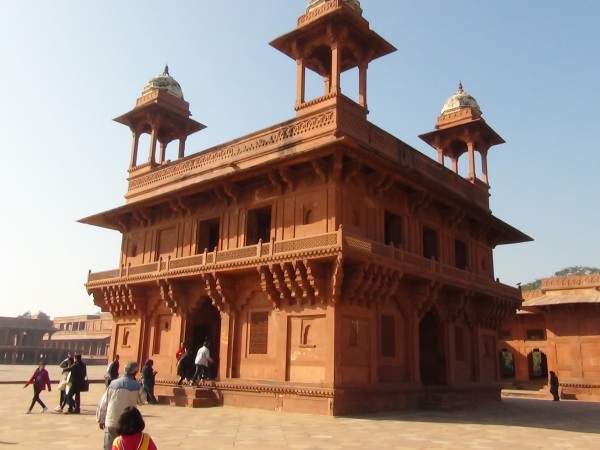
Diwan-i-khas
Emperor Akbar was tolerant towards all religions and it was at Diwan-i-khas that he met with scholars of different religion to discuss various philosophies. A central pillar with circular platform with arms emanating from the platform was the seat of all discussions.
Hiran Minar

Hiran Minar
An 80 feet high brick watch tower with projections that imitate elephant tusks could have been a starting point for milestone posts many of which are seen in Agra in ruinous state.
There are more structures within the complex like Birbal’s house, Taksal or Mint, Queen’s residence, Caravan Sarai, records office, karkhana or workshop, treasury.

Caravan Sarai
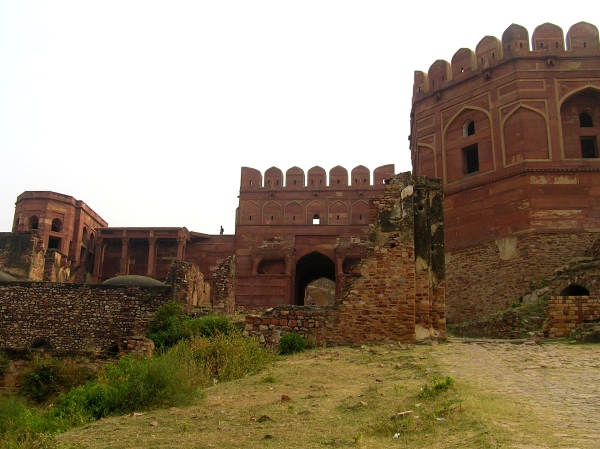
Hathi Pol
The spring fed lake however came under tremendous burden of catering to the needs of the military and civil populace and maintenance of the walled city built in stone.
Thus a magnificent city such as this had to be abandoned for lack of water.
Imagine our water sources drying up now….would we be able to give up our city as easily and start afresh? What happens when other cities hope to migrate closer to diminishing water sources too?
There will ensue a war so violent not only between two different people but between families…thirst will drive man to kill each other and all would be lost.
It is time we wake up to the reality that water is diminishing slowly and we need to do everything we can to save water..water harvesting, planting trees and most of all stop wasting this elixir of life.
Livpure has come up with an initiative #cuttingpaani to save water. Let us teach our children to save earth, save water to save ourselves.
Quick Facts:
- Fatehpur Sikri is 40 kilometer from Agra.
- Agra is well-connected by rail and road to most major cities.
- The airport at Agra caters charter flights during tourist season. It is not a civil airport otherwise.
- Check the guides credentials before hiring.
- Carry sun shades, water, scarves as the sun can be very harsh.
- Winters are chilly at Agra with foggy mornings. Summers are hot and dry.
- Best season would be when monsoons are beginning. The city becomes slightly cooler. However heavy rain period causes a lot of drainage issues in the town of Agra and is best avoided.
- Other important must do places in Agra are Taj Mahal, Agra Fort, Sikandara or Akbar’s tomb, Itmad-ud-Daula’s tomb.
- February sees the celebration of cultural festival Taj Mahotsav.
- A visit to Kalakriti is must for musical play on Taj Mahal. Marble artisans and their work is on display in this cultural center as well.
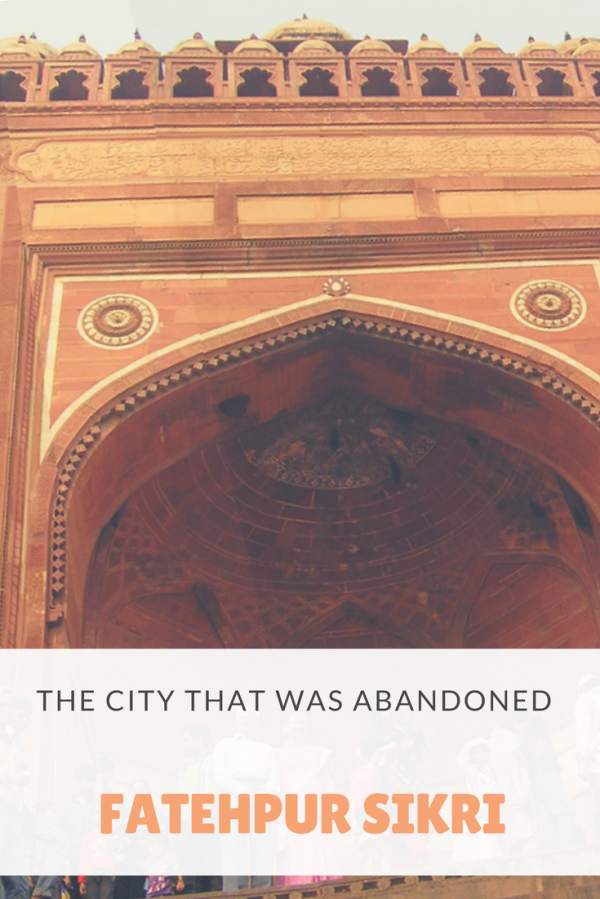
Fatehpur Sikri


So much craft in these buildings. And such a grand complex this one is.
I missed Fatehpur Sikri during during my visits that side. You detailed post was quite a tour of the place. Thank you, Shoma. 🙂
LikeLike
Thank you. If only the stones could speak, we would have been transported to those times and see first hand the life then.
LikeLike
Nice and detailed information with beautiful photos 👍 Buland Darwaza looks huge.
Thanks for sharing 🙂
LikeLike
Thank you Sachin. Buland darwaza is just that ‘buland’ in all respects so yes it is huge.
LikeLike
A truly heart warming article with some stunning photographs to go with it! Kudos 🙂
Also, visit http://www.wheelstreet.com to book all your favorite bikes at the most affordable prices in India.
LikeLike
Thank you
LikeLike
Stunning your all pictures and article too really nice thanks for sharing n keep it up thanks a lot !
LikeLike
Thank you Karan. This comment had somehow landed in spam and hence the late reply.
LikeLike
Good to read this… Cover photo clicked in good angle.
LikeLiked by 1 person
Thank you. The credit for the pic goes to my husband.
LikeLike
Magnificent 🙂 Keep Glittering ; Love TGA By Misha ! Rise N shine
LikeLiked by 1 person
Thank you
LikeLike
you have an Amazing blog dear and it is always an inspiration to a beginner like me.. Kindly follow my blog too if you like it. 😊
LikeLike
Thank you
LikeLike
Thanking for post these all pictures of India’s Real Beautiful Pictures. I love to visit forts and historical places with description you share your experience to all. Thank a lot
LikeLiked by 1 person
You are welcome. I love visiting forts too.
LikeLike
This is grand, huge and majestic.
It is always interesting and fascinating to know about such ancient places…
LikeLiked by 1 person
We have a huge repository of heritage…need is to maintain it for future generations for them to know history.
LikeLiked by 1 person
So wonderful and great memories for me.
LikeLike
Thank you. Glad it inspired memories.
LikeLiked by 1 person